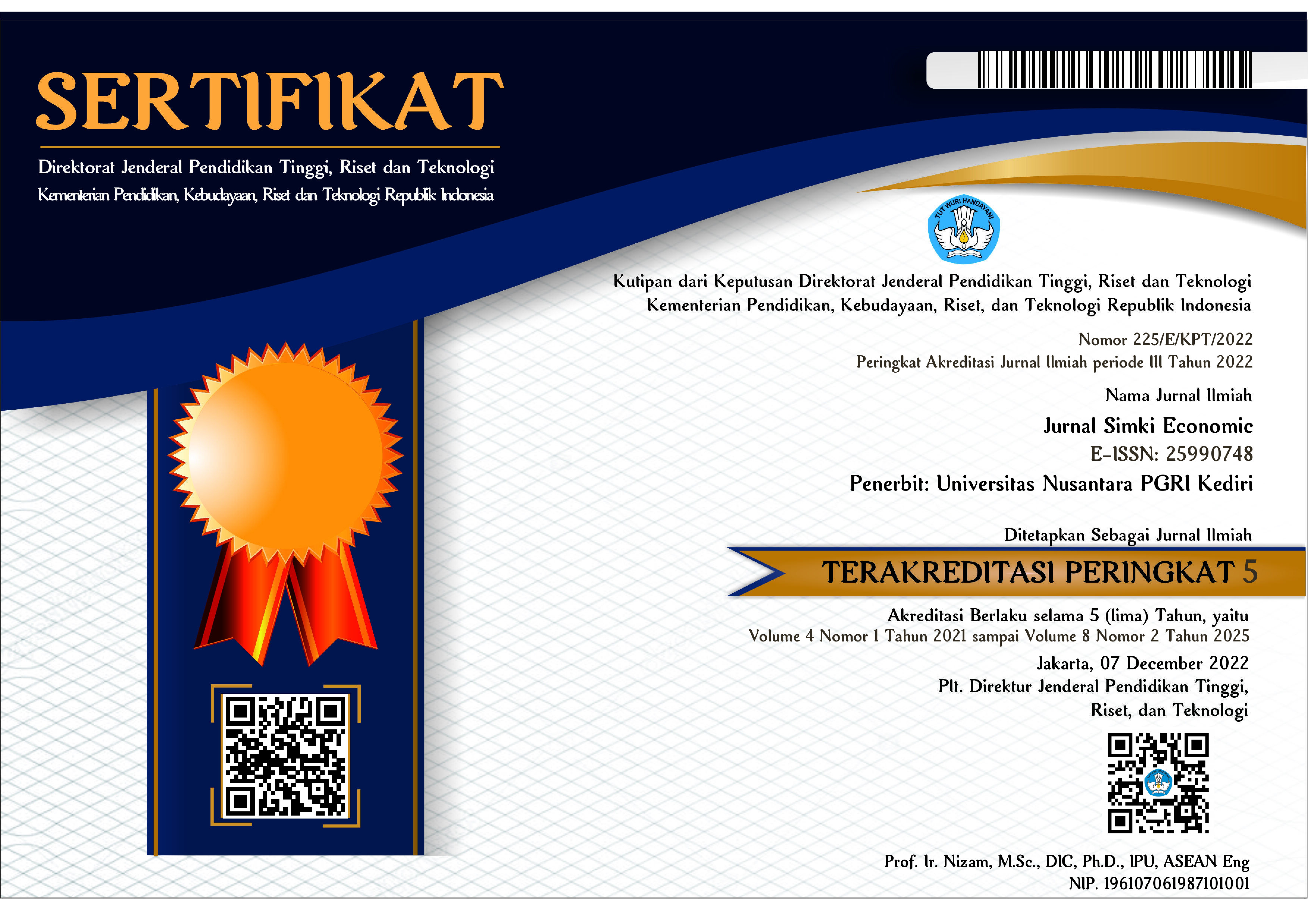Analisa Pengaruh Sosial Media Instagram terhadap Perilaku Belanja Online dengan SEM-GesCa
 Abstract views: 537
,
Abstract views: 537
,
 PDF (Bahasa Indonesia) downloads: 625
PDF (Bahasa Indonesia) downloads: 625
Abstract
The social media platform that is currently popular is Instagram, with a user base of 109.3 million people as of April 2023. This number has continued to increase by 3.45% compared to March, which had 105.68 million users. With the large number of Instagram users, there has been a rise in online stores that create accounts and utilize various features on Instagram for trading purposes. As more online stores open accounts on Instagram, many users become more consumptive upon seeing posts on their Instagram timeline. Therefore, the author intends to analyze the influence of Instagram on users' online shopping behavior. The research was conducted by distributing questionnaires to respondents through the social media platform Twitter and analyzing the questionnaire data using SEM-GesCA. There were 96 respondents who completed the questionnaire, with 52% of them being male. The results obtained from this study indicate that the social media platform Instagram has a negative influence on users' online shopping behavior.
Downloads
References
Allcott, H., & Gentzkow, M. (2017). Social Media and Fake News in the 2016. Journal of Economic Perspectives, 31(2), 211-236. http://dx.doi.org/10.1257/jep.31.2.211
Aran, O., & Gatica-Perez, D. (2013). Cross-domain personality prediction: from video blogs to small group meetings. Proceedings of the 15th ACM on International conference on multimodal interaction (pp. 127-130). ICMI '13. http://dx.doi.org/10.1145/2522848.2522858
Baird, C. H., & Parasnis, G. (2011). From social media to social customer relationship management. Strategy & Leadership, 39(5), 30-37. http://dx.doi.org/10.1108/10878571111161507
Belanche, D., Cenjor, I., & Pérez-Rueda, A. (2019). Instagram Stories versus Facebook Wall: an advertising effectiveness analysis. Spanish Journal of Marketing – ESIC, 69-94. http://dx.doi.org/10.1108/SJME-09-2018-0042
Dickson, K., Richardson, M., Kwan, I., MacDowall, W., Burchett, H., C, S., . . . Thomas, J. (2018). reviews, Screen-based activities and children and young people’s mental health and psychosocial wellbeing: a systematic map of. London: EPPI-Centre: Social Science Research Unit, UCL Institute of Education, University College London. http://dx.doi.org/10.1089/cyber.2019.0370
Erdoğmuş, İ. E., & Çiçek, M. (2012). The Impact of Social Media Marketing on Brand Loyalty. Procedia - Social and Behavioral Sciences, 58, 1353-1360. http://dx.doi.org/10.1016/j.sbspro.2012.09.1119
Flavián, C., Gurrea, R., & Orús, C. (2009). The effect of product presentation mode on the perceived content and continent quality of web sites. Online Information Review, 1103-1128. http://dx.doi.org/10.1108/14684520911011034
Forbes. (2015). Strategies to Drive Customer Engagement in 2015. Retrieved November 11, 2019, from https://www.forbes.com/sites/forbesinsights/2015/01/29/6-strategies-to-drive-customerengagement-in-2015
Funch, S. (2008). Internet and society, social theory in the information age. Madison Ave: NY: Roudledge. http://dx.doi.org/10.7146/mediekultur.v26i48.2316
Husnain, A., Din, S. M., Hussain, G., & Ghayor, Y. (2017). Estimating Market Trends By. 13th International Conference on Emerging Technologies , 1-6.
Instagram. (2023, April 20). instagram features. Retrieved from instagram: https://about.instagram.com/features
Institute, M. S. (2010-2012). Understanding Customer Experience and Behaviour.
Iman, D., Arifin, Z., & Mawardi, K. (2015). Pengaruh Pemasaran Melalui Media Sosial Terhadap Kesadaran Konsumen Pada Produk Internasional. Jurnal Administrasi Bisnis , 24(1). http://administrasibisnis.studentjournal.ub.ac.id/index.php/jab/article/view/938
Karayanni, D. A. (2003). Web‐shoppers and non‐shoppers: compatibility, relative advantage and demographics. European Business Review, 15(3), 141–152. http://dx.doi.org/10.1108/09555340310474640
Kim, D. J., Ferrin, D. L., & Rao, H. R. (2008). A trust-based consumer decision-making model in electronic commerce: The role of trust, perceived risk, and their antecedents. Decision Support Systems, 44(2), 544–564. http://dx.doi.org/10.1016/j.dss.2007.07.001
Koay, K., Ong, D., Khoo, K., & Yeoh, H. (2020). Perceived social media marketing activities and consumer-based brand equity: Testing a moderated mediation mode. Asia Pac. J. Mark. Logist., 53-72. http://dx.doi.org/10.1108/APJML-07-2019-0453
Kotler, P. (2000). Dasar –dasar Pemasaran Jilid 1 (1 ed.). Jakarta: Prenhalindo.
Kotler, P., & Keller, K. L. (2009). Manajemen pemasaran (1 ed.). Jakarta: Erlangga.
Krisdyahayu, M. R. (2018). Kompasiana. Retrieved November 11, 2019, from https://www.kompasiana.com/mariarosarikrisdyahayu6905/5b981cd312ae9437ca69f295/sejarah-internet-dan-perkembangan-media-sosial-di-indonesia-dari-friendster-hingga-snapchat?page=all
Liang, T. P., & Lai, H. J. (2002). Effect of store design on consumer purchases: An empirical study of on-line bookstores. Information and Management, 39(6), 431-444. http://dx.doi.org/10.1016/S0378-7206(01)00129-X
Miles, B. M., & Huberman, A. M. (1994). Qualitative Data Analysis (2 ed.). London: International and Professional Publisher.
Nasrullah, R. (2015). Media sosial (perspektif komunikasi, budaya, dan sosioteknologi). Jakarta: Simbiosa Rekatama Media.
Richter, A., & Koch, M. (2008). Functions of Social Networking Services. COOP 2008: Proceedings of the 8th International Conference on Designing Cooperative Systems.
Rizaty, M. A. (2023, April 20). Data Indonesia. Retrieved from Pengguna Instagram di Indonesia Capai 109,3 Juta per April 2023 Artikel ini telah tayang di Dataindonesia.id dengan judul "Pengguna Instagram di Indonesia Capai 109,3 Juta per April 2023"., https://dataindonesia.id/digital/detail/pengguna-instagram-di-indonesia-capai-1093-juta-per-april-2023
Saryono. (2010). Metode Penelitian Kualitatif. Bandung: PT. Alfabeta.
Sugiyono. (2011). Metode Penelitian Kuantitatif, Kualitatif dan R&D. Bandung: Alfabeta.
Trianto, B., Barus, E. E., & Sabiu, T. T. (2021). Relationship Between Islamic Financial Literacy, Islamic Financial Inclusion And Business Performance : Evidence From Culinary Cluster Of Creative Economy. Jurnal Ekonomi dan Bisnis Islam, 19-38. https://doi.org/10.24042/febi.v6i1.7946
Tripathi, M. N. (2009). Customer Engagement-Key to Successful Brand Building. The XIMB Journal of Management, 6, 131-140.
Widi, S. (2023, April 20). Pengguna Media Sosial di Indonesia Sebanyak 167 Juta pada 2023 Artikel ini telah tayang di Dataindonesia.id dengan judul "Pengguna Media Sosial di Indonesia Sebanyak 167 Juta pada 2023"., Retrieved from Data Indonesia: https://dataindonesia.id/internet/detail/pengguna-media-sosial-di-indonesia-sebanyak-167-juta-pada-2023
Websindo. (2019). Indonesia Digital 2019 : Media Sosial. Retrieved November 11, 2019, from https://websindo.com/indonesia-digital-2019-media-sosial/
Yudha, A., & Martanti, E. (2022). Improving Financial Behavior Of Millennial Generation Through Attitude, Knowledge, And Confidence During The Covid-19 Pandemic. Journal of Applied Management. http://dx.doi.org/10.21776/ub.jam.2022.020.01.19
Copyright (c) 2023 Khoirunnisa' Afandi, M. Habibullah Arief, Emha Diambang Ramadhany, Muhammad Rapita Kun Panuluh

This work is licensed under a Creative Commons Attribution 4.0 International License.














